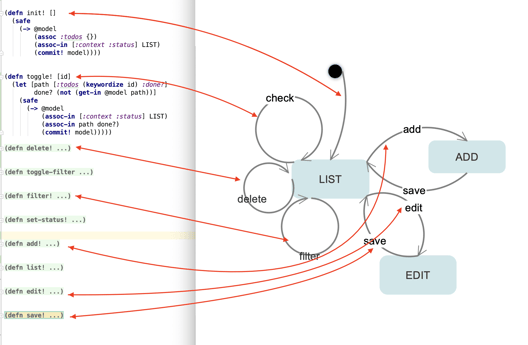
- By Javier Martínez
- ·
- Posted 10 Aug 2021
Functional patterns
Welcome pythonistas! In our last video session on design patterns we focused exclusively on patterns for the object oriented paradigm (OOP). To some..
Lambda Calculus is the smallest programming language. As we saw on my previous post, the only building blocks available are functions, variables and expressions. There are no built-in primitive values or operations. How can we then solve real-world problems using Lambda Calculus?
In this post, we are going to create a set of building blocks, using lambda expressions, to calculate boolean expressions. For this, we are going to use Clojure, which is a dynamic functional language based on Lambda Calculus.
A mathematician called Alonzo Church was able to encode data and operators in Lambda Calculus. Church encoding is the name of this way of building primitive terms and operations, converting them into higher-order functions that can be combined to create more complex expressions.
There are a few different primitives that can be constructed in Church Encoding:
Each of these primitives have their own operators, that can be built in a similar way to the values of the primitives. This gives us the basic building blocks for writing programs in Lambda Calculus. For the rest of this post, we are going to focus on Church booleans.
In boolean logic, there are only two possible values, true and false. As we saw previously, Lambda Calculus doesn’t provide any primitive values, but we can define them in Church Encoding. Given a lambda function with two parameters, we define true and false as following:
true = λa.λb.a
false = λa.λb.b
Looking at this definition, we can see that true is a function of two parameters that returns the first one. Similarly, false returns the second parameter.
Apart from primitive values, we need some operators in order to complete a boolean algebra and write programs. We can define the boolean operators based on the definitions for true and false above:
and = λp.λq.p q p
or = λp.λq.p p q
and returns q if p is true; otherwise, returns p, which equals to false. We can use the definition of true and false above to see the substitution in detail:
When p is true:
p = true = λa.λb.a
and = λp.λq.p q p = λp.λq.((λa.λb.a)(q p)) = λp.λq.q = q
When p is false:
p = false = λa.λb.b
and = λp.λq.p q p = λp.λq.((λa.λb.b)(q p)) = λp.λq.p = p = false
or works in a similar way.
not = λp.p false true
Applying the same reasoning, not just inverts the value of p, returning false if p is true, and returning true otherwise.
The last operator is Exclusive OR:
xor = λa.λb.a (not b) b
which follows the same rules as the previous operators.
It’s also possible to define an if predicate, similar to the ones we use in most programming languages:
if = λp.λa.λb.p a b
The predicate p is applied to the arguments a and b, returning a if the predicate evaluates to true, and b if the predicate evaluates to false.
After defining the boolean algebra in Church Encoding, we are ready to start building it in Clojure.
Clojure has built-in anonymous functions, which can be used to simulate functions in Lambda Calculus. For example, the identity function would look like this:
(fn [x] x)
fn is the anonymous function definition.[x] is the parameter of the function.x is the body of the function.Does this look familiar? We could rewrite this expression in Lambda Calculus:
(λx.x)
Both expressions look quite similar. This is because Clojure is based on Lambda Calculus. But, what if we could add some syntactic sugar to the recipe and make Clojure’s anonymous functions even closer to their Lambda Calculus counterparts?
Macros in Clojure are extremely powerful. They are used to extend the language. Let’s redefine the anonymous function as a λ function:
(defmacro λ
[args & body]
`(fn [~args] ~@body))
This macro will take the first element after λ and make it the single argument of an anonymous function, which will take the rest of the form as the body. This allows us to rewrite the original identity function (fn [x] x) as (λ x x), which is very close to the Lambda Calculus syntax (λx.x).
Now, we can start building the boolean algebra using our new shiny syntax.
Let’s start with true and false. As they are reserved words in Clojure, we are going to rename them to T and F:
; true = λa.λb.a
(def T
(λ a (λ b a)))
; false = λa.λb.b
(def F
(λ a (λ b b)))
Notice that we are using def instead of defn, to define the term, which is a higher-order function (returning a function, in this case). The difference between them is that defn will be evaluated every time it’s called, whereas def will only be evaluated once. This is not strictly necessary for our purposes, but doing so, we can reinforce the idea that lambda expressions always return the same result when evaluated.
The boolean operators implementation follows a similar idea to true and false:
; and = λp.λq.p q p
(def And
(λ p (λ q ((p q) p))))
; or = λp.λq.p p q
(def Or
(λ p (λ q ((p p) q))))
; not = λp.λa.λb.p false true
(def Not
(λ p ((p F) T)))
; xor = λa.λb.a (not b) b
(def Xor
(λ a (λ b ((a (Not b)) b))))
; if = λp.λa.λb.p a b
(def If
(λ p (λ a (λ b ((p a) b)))))
Now that we have implemented our boolean algebra, we can start evaluating boolean expressions. In order to help us check the results, we can add a function to convert a λ-boolean into a Clojure boolean:
(def toBoolean
(λ f ((f true) false)))
Let’s try to evaluate a few expressions:
; true AND true
=> (toBoolean ((And T) T))
true
Similarly,
; true AND false
=> (toBoolean ((And T) F))
false
To evaluate more complex expressions, we just need to nest boolean expressions:
(deftest λ-booleans
(testing "Boolean expressions"
;T AND T AND F OR T
(is (= (toBoolean ((And T) ((And T) ((Or F) T))))
true))
;T AND F AND F OR T AND T
(is (= (toBoolean ((And T) ((And F) ((Or F) ((And T) T)))))
false))
;T OR (F AND F OR T AND T)
(is (= (toBoolean ((Or T) ((And F) ((Or F) ((And T) T)))))
true))
;F OR (F AND F OR F AND T)
(is (= (toBoolean ((Or F) ((And F) ((Or F) ((And F) T)))))
false))
;F OR F AND F OR T AND T
(is (= (toBoolean ((And ((Or F) F)) ((And T) ((Or F) T))))
false))
;T OR F AND F OR T AND T
(is (= (toBoolean ((And ((Or T) F)) ((And T) ((Or F) T))))
true))))
You can find the source code here.
The Church-Turing Thesis states that any computation that is Turing computable can be represented using Church encoding. We’ve seen how to do this for boolean expressions. In part 2, we will implement a numerals algebra.
http://blog.errstr.com/2012/01/14/church-encoding/
Programming With Nothing by Tom Stuart

Welcome pythonistas! In our last video session on design patterns we focused exclusively on patterns for the object oriented paradigm (OOP). To some..

Solving a simple problem in Elixir In this article, I am going to solve the Word Count problem from Exercism in Elixir. I'll start with a form that..

Crafting web apps using finite state machines - Part 1 Code on Gitlab
Join our newsletter for expert tips and inspirational case studies
Join our newsletter for expert tips and inspirational case studies